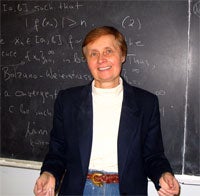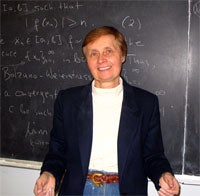 Awarded NSF grant to help math and science educators
Awarded NSF grant to help math and science educators
KINGSTON, R.I. — February 2, 2006 — If you think that women and math don’t add up, you should meet Barbara Kaskosz of South Kingstown.
For the past 27 years, the professor has taught mathematics to hundreds if not thousands of students at the University of Rhode Island.
Not one to rest on her formulas, the math whiz is always on the lookout for new and better learning materials to help students in her calculus and introductory math analysis courses understand and visualize mathematical and science concepts.
Three years ago the South Kingstown resident began creating some 3-dimensional, interactive web materials using the new and powerful software called Flash 8.
“I am a Flasher,” says Kaskosz with a lingering Polish accent and mischievous grin, noting that she was able to create such exciting materials by using Flash.
Flash, for the technology-challenged, is a popular multimedia, authoring program commonly used to create animations, advertisements, design elements on a web page, and video to websites. The new technology is rapidly replacing other software, which has become plagued by incompatibility issues.
Recognizing her expertise as a Flash programmer, the National Science Foundation recently awarded the URI professor a two-year, $114,500 grant.
The grant is designed to help open the technological door to other educators so they can develop interactive, visually engaging, web-based materials for students studying math and science in Flash.
The classes (a suite of reusable, self-contained blocks of software code) Kaskosz programmed for her students are commonly needed for math and science applications. Her codes convert math into graphs and 3-dimensional renderings, which allow her students not only to visualize the concepts, but to interact with them by reconfiguring numbers and formulas and watching what happens. They can, so to speak, play with them.
“These codes are universal,” says Kaskosz with obvious pride. They can be used by elementary school educators and for serious science applications.
Word of her Flash codes spread quickly and her mailbox became jammed with thousands of e-mails from educators around the world requesting them.
Thanks to the NSF grant, the URI professor and her collaborator Douglas Ensley, a professor at Shippensburg University in Pennsylvania, have just launched a Flash Forum for educators at http://www.mathdl.org/mathDL/3/, which provides their codes as well as templates so that other programmers can customize them with their own codes and develop new Flash-based learning materials. The site will offer a virtual classroom for other developers with an interactive tutorial. The online forum will help form a community of educators interested in developing materials in Flash to exchange ideas and build upon each other’s work.
Kaskosz and Ensley will conduct a series of workshops at the major mathematics meetings and conferences devoted to specifically using technology in teaching, including a workshop at the URI Kingston campus in the summer of 2007.
“Visualization, interactivity, and self-paced exploration are essential in teaching mathematics and sciences,” says Kaskosz. “Sound web-based materials provide all those features. They have already become an important part of mathematics and science education and, without a doubt, their role will increase in the future. It makes me happy to play a small part in this important effort.”

